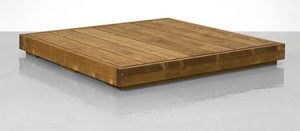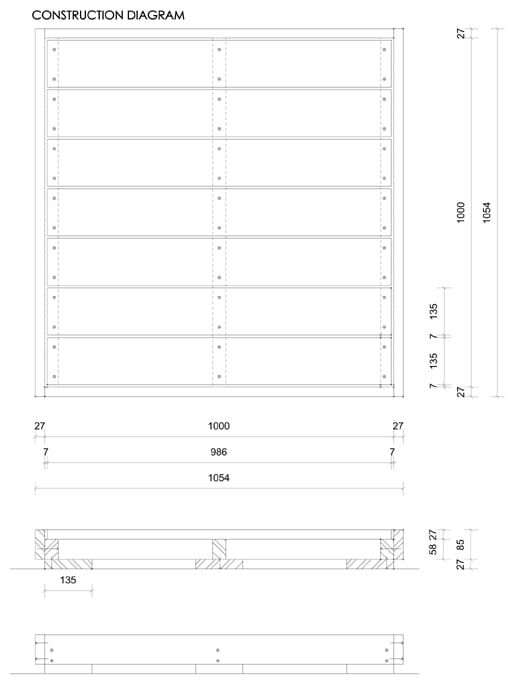How To Build a Freestanding Deck
Not only gorgeous to look at, building your own freestanding deck allows you to set up an entertainment area wherever you like, without having to spend money on plans and waiting months for approval. A basic timber deck like the one in this project, won’t cost a fortune but will add to the value of your property.
What could be more basic than building your own timber deck. You can build your deck of pine (soft), meranti, saligna, or a variety of other hardwoods, depending on how much you want to spend.
The substructure of this deck consists of two supports that bear the frame and the deck planks. The frame overhangs the substructure, so that the deck planks, which are screwed to the supports, are enclosed and aligned within the frame. If you want to build a larger deck, bear in mind that you will need an additional support for every 50 to 60 cm of deck. The following assembly instructions apply to 27-mm-thick laminated timber. You must adapt the list of materials accordingly if you opt for other materials or thicknesses. You can also modify the measurements to build a deck of a specific size and shape. If possible, ask your local Builders Warehouse store to cut the required boards to size.
- Orbital or Random OrbitSander plus 120-, 180- & 240-grit sanding pads
- Drill/Driver plus assorted bits
- Countersink bit
- Wood screws (4 x 60mm), pack
- Woodoc Deck Sealer or Woodoc Deck Dressing
- Woodoc steelwool
- Paintbrush
- Clean cloths
- Tape measure and pencil
Assemble the supports
Start by fastening the supports with screws. Each of the supports is made from a square timber combined with a base plank. The two outer square timbers are upright and aligned on the outside edge, while the centre square timber is positioned in the middle of the base planks. Using the cordless screwdriver and screws (4 x 60 mm), mount the square timbers from below through the base planks.
Mount the frame and supports
Lay the frame surrounds with the visible surfaces facing down in the way you want to assemble them. The short frame surrounds are enclosed within the long frame surrounds. Using the cordless screwdriver and screws (4 x 60 mm), join the surrounds to form a single frame. Refer to our tip on screwing together two pieces of wood in the previous section.
Mount the supports so they are parallel with the long frame surrounds and flush below with the square timbers in the frame. The base planks are facing upwards. Place the plank with the centrally-fastened square timber in the middle of the frame and the planks with the left and right-fastened square timbers to the left and right respectively. Use the cordless screwdriver and screws (4 x 60 mm) to fasten the supports in place. Refer again to our tip on screwing together two pieces of wood.
Mount the deck planks
Pre-drill the deck planks in preparation for fastening them with screws. Position two holes in the centre above the square timbers and countersink the holes. Place the deck planks inside the frame on top of the supports using 7-mm spacer blocks and mount them in place with the cordless screwdriver and screws (4 x 60 mm).
Sand wood surfaces
Take time to prepare the wood surfaces so they are in the best possible working condition before starting assembly. First chamfer all edges with sanding paper with a grit of 120 at a 45° angle until a small bevel is created. Use your sander to sand all visible surfaces in the direction of the wood grain, first with coarse sanding paper (grit of 120, 180) and then with fine sanding paper (grit of up to 240). Damp sponge the surfaces afterwards to wipe off the dust. Some loose wood fibres may protrude while the wood is drying. You can remove these with sanding paper with a grit of 180. The wood is now ready for surface treatment. Little tip: Make sure that the sanding paper is sharp enough to remove the wood fibres properly, not just flatten them.
Stain and seal the surfaces
There are two options for staining and sealing your new deck, and it all depends on the timber that you have used.
Woodoc Deck Sealer is a gloss re-enforced sealer especially formulated for porous wood decks and decking. It deep penetrates to nourish the wood and bond with it, forming a tough and hard-wearing, UV- and water resistant surface finish. Suitable for e.g. SA Pine and porous Meranti. Woodoc DECK Sealer is available in Golden Brown, Rich Meranti and Deep Brown.
Woodoc Deck Dressing is a tinted wood dressing formulated to protect and treat dense wood decking and decks that do not readily accept a conventional sealer e.g. Balau, Rhodesian Teak, Garapa and Iroko. High in UV-absorbers, as well as water repellent, it is ideal for first time treatment and maintenance of decks. It is also suitable for rough-sawn wood.















Comments
Add comment